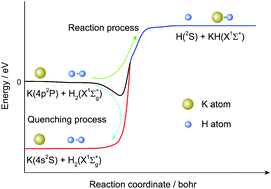Non-adiabatic dynamics studies of the K(4p2P) + H2(X1Σ +g) reaction based on new diabatic potential energy surfaces
Abstract
Global diabatic potential energy surfaces (PESs) of the KH2 system corresponding to the ground (12A′) and first excited (22A′) states were constructed for the first time. In ab initio calculations, the MRCI-F12 method with AVTZ and def2-QZVP basis sets was adopted and 17 865 ab initio energy points were calculated. The mixing angle, which is used to obtain the diabatic energies, was calculated by the molecular properties of the transition dipole moment. The diabatic PESs were fitted individually by the permutation invariant polynomial neural network method and the topographical features of the diabatic PESs are discussed in detail. The non-adiabatic dynamics studies of the K(4p2P) + H2(v0 = 0, 1, j0 = 0) reaction were carried out using the APH method based on the new diabatic PESs. The collision reaction processes K(4p2P) + H2(v0 = 0, 1, j0 = 0) → H + KH and the quenching processes K(4p2P) + H2(v0 = 0, 1, j0 = 0) → K(4s2S) + H2 were studied at the state-to-state level of theory. For the reaction process, the dynamics results indicated that the vibrational excitation of H2 was significantly more effective at promoting the reaction than the translational energy. In addition, the differential cross-sections were forward-biased scattering, which indicated that the direct abstraction mechanism plays a dominant role in the reaction. For the quenching process, the vibrational excitation of H2 molecules could improve the quenching efficiency obviously.

- This article is part of the themed collection: Emerging AI Approaches in Physical Chemistry


 Please wait while we load your content...
Please wait while we load your content...